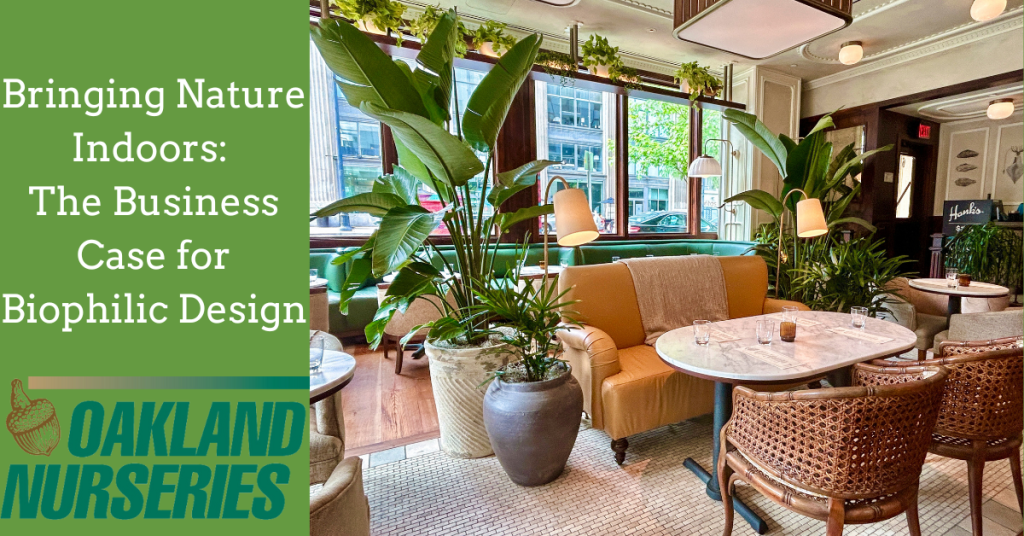In today's business world, companies are constantly seeking ways to enhance productivity, boost employee satisfaction, and improve their bottom line. One innovative approach to address these challenges is biophilic design – thoughtfully incorporating natural elements into the built environment through direct and indirect means. By reconnecting employees with nature, businesses can reap significant benefits and see a tangible return on investment.
What is Biophilic Design?
Biophilic design is the practical application of biophilia: the understanding that humans have an innate and evolutionary connection to nature, one that is critical for our physical and mental wellbeing- even today. Humans have spent most of our evolutionary history in close connection with nature; it is only in the last two-three hundred years of human existence that we have moved into concentrated, urban environments with less access to the natural world.
The biophilic design approach seeks to bring elements of the natural world into our indoor spaces, particularly workplaces where we spend a significant portion of our time. Studies over the last forty years have demonstrated that humans have positive physical and emotional responses when they have access to nature, everything from lowered blood pressure, heart rates, and stress hormones, to increases in creativity and concentration. Biophilic design seeks to enhance these responses by integrating nature and natural elements into our built environments.

The Business Benefits & ROI of Biophilic Design
While the initial investment in biophilic design may seem significant, the long-term returns can be substantial. Incorporating biophilic design in your workplace can lead to numerous advantages:
- Increased Creativity: A study conducted by the University of Exeter found that introducing plants into office spaces increased creativity by 45%. This substantial boost in creative thinking demonstrates the powerful impact that biophilic design elements can have on employee performance.
- Enhanced Productivity: The same study revealed that productivity increased by 38% when plants were added to previously sparse office environments. Plants can dampen the sound in a loud, hard-surfaced room, allowing teams to focus and concentrate. This improvement in output can translate directly to a company's bottom line.
- Improved Air Quality: Plants act as natural air purifiers, removing up to 87% of indoor air toxins within 24 hours, according to NASA research. Better air quality can lead to improved cognitive function and overall well-being.
- Reduced Stress: Imagine the feelings you experience when you are sitting outside and looking at a scenic vista or beautiful landscape. Similar feelings can be generated when plants are incorporated into interior environments. Employees working in offices with natural elements reported a 15% decrease in stress levels compared to those in environments without plants.
- Increased Attention Span: Studies have shown that the presence of plants can increase attention span by up to 20%.
- Lower Absenteeism: Offices with plants experienced a 15% reduction in employee sick days. The costs associated with employee absenteeism can be up to $3600 per employee, per year.
Implementing Biophilic Design
How can an employer take advantage of the benefits of biophilic design? There are various ways at various price points to apply biophilic design elements into your workplace:
- Natural Light: Maximize exposure to daylight through windows and skylights. Even artificial light that mimics natural light can provide a big improvement to a space.
- Indoor Plants & other Natural Elements: Introduce living plants throughout the office space. Whether in the form of floor plants, living walls, or even moss walls, thoughtful integration of plants can dramatically improve the well-being of a room.
- Natural Materials & Patterns: Use wood, stone, and other natural materials in furnishings and decor. Natural patterns in wall or floor coverings also trigger biophilic responses in humans.
- Nature Views: Provide views of outdoor green spaces or install nature-themed artwork.
- Water Features: Incorporate fountains or other water elements to create a calming atmosphere.

Conclusion
Biophilic design is more than just an aesthetic choice; it is a strategic business decision. By creating workspaces that nurture our innate connection to nature, companies can cultivate healthier, happier, and more productive employees. In today's competitive business landscape, the benefits of biophilic design offer a compelling advantage that creates better workspaces for employees and employers!
Want to learn more about how biophilic design can make your workplace healthier and happier? Connect with the design experts at Oakland Green Interiors—we can even show you financial ROIs when you invest in workplace plants! www.oaklandgreeninteriors.com

Thank you to Genevieve Reiner Mills with Oakland Nurseries for providing this valuable information.
If you are interested in being featured on our Family Business Insights or have any questions please contact lflint@familybusinesscenter.com

